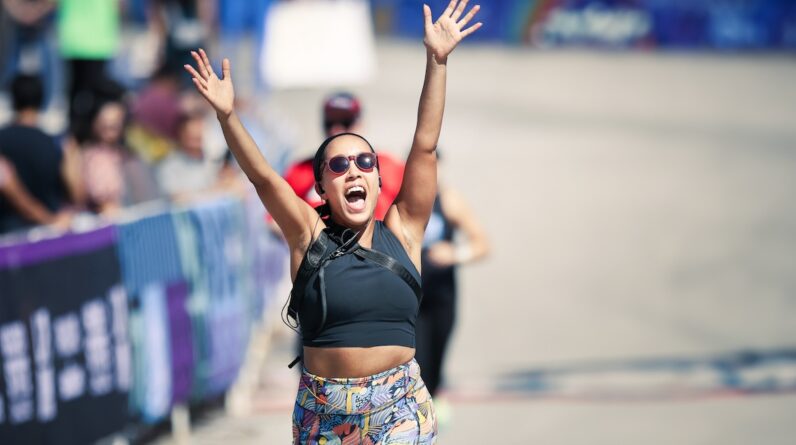
But instead of stressing over the demise of my race pace—like I had the previous two times—I found myself embracing “party pace.” I high fived as many kids as I could. I pulled out some dance moves at a neighborhood DJ station. I might have even downed a shot of beer in the final mile. (Hey, carbonation can soothe an upset tummy, right?)
What made the difference this time around: I had a luxurious 7 hours and 45 minutes to get to the end and still be counted as an official finisher. Even if I had to walk the rest of the way, I’d still cross the finish line in time to get a medal wrapped around my neck. By contrast, most marathons shut down after about six hours. Runners that aren’t moving fast enough to make that cutoff might get redirected to the sidewalks or picked up in a bus, and aid station amenities like water will disappear.
I’d argue that no matter the race distance, giving all the runners who enter enough time to get to the finish line completely changes the mood on a course, in the best way. Back-of-the-pack runners might benefit in the most obvious ways. But even faster runners will tell you that when you’re doing a race where nearly everyone has good odds of finishing, there’s a certain feeling of possibility, a celebratory energy that’s downright contagious.
I could tell I wasn’t the only runner at EWM who was loving the generous cutoff time—plenty of other racers I passed on out-and-backs were vibing. So afterward, I asked around to see if other people were picking up on a similar effect.
A few told me the lengthy cutoff didn’t just make the race more fun, it made it more meaningful. “I felt truly accepted and embraced for where my physical abilities were at—that was powerful,” Leslie Robbins, a runner from Cleveland, told me.
Multiple runners said they signed up for EWM solely because of the extended time. “One of the things that had [previously] made me stop from thinking of ever doing a full [marathon] is I knew I couldn’t meet the time limit, and I didn’t want to push myself that hard,” says Stacy Smith, a runner from Michigan. “But I was like, ‘I can do 7 hours 45 minutes.’” She wasn’t alone: More than 40 percent of EWM runners were racing their very first marathon.
At half marathons Smith has done in the past, she’s felt stressed out through every mile, telling herself to hurry up to avoid the “sad wagon” that picks up too-slow runners. Even when she finishes with some extra minutes to spare, the aid stations or the finish line festival are sometimes empty by the time she gets there. “It’s definitely a really lonely feeling,” she says.
Everyone is out there together moving in the same direction even though they come from all backgrounds and with all kinds of relationships to running.
“It makes you feel kind of uncared about,” adds Sarah Deyerle, an ultrarunner from Charleston, South Carolina. “That’s just so hard on your mentality when you’re coming in and they’re already starting to take bits and pieces of the finish or the shoot down.”
Deyerle has been running for about a decade and says she’s recently gotten more into trail running, largely because races typically have looser cutoff requirements. “There are a million other obstacles you’re going to encounter, but it’s nice to be able to remove that,” she says.
There were some runners at EWM who didn’t make the cutoff, or found themselves rerouted because their pace was too slow. Other races out there are more generous, and some have no cutoff time at all.
Take Mainly Marathons, a race series that puts on multi-day events with distances from 5K to 50K, and only gives time limits for the 50K. Daniel Rueckert, co-race director, says the founder, Clint Burleson, started the series because as he got older, his slowing pace made big-city races too difficult, but he still wanted to run. So he started his own event, creating a relaxed, pressure-free space where anyone who’s determined enough can finish.
“Everyone is just cheering each other on,” Rueckert says. “Some people might have their own personal goals, but really, no one is racing each other at our races.”
Giving runners more time creates a more low-key vibe that anyone who’s ever done a local, walker-friendly Turkey Trot might recognize: Everyone is out there together moving in the same direction even though they come from all backgrounds and with all kinds of relationships to running. Some may be aiming for a PR while others aren’t sure what “PR” stands for. Anyone can just have fun on the course in whatever way they want to.
Of course, there are legit reasons why most races give runners a limited amount of time. “It’s not easy on any city to keep the community locked in their neighborhoods or unable to access certain routes,” says Miranda Abney, vice president of consumer marketing at MilkPEP, which put on EWM. She told me that they had initially wanted to keep the EWM course open for 8 hours, but settled on 15 minutes less after back-and-forth negotiations with the city, county, and state. “So many different people have to be involved in approving your route and your times,” Abney says.
And street closures don’t come free. “It costs lots of money to shut down some of those roads, especially for extended periods of time,” Rueckert says. In order to keep Mainly Marathons’ finish line open for about 9 to 11 hours, he says their courses are designed as out-and-back laps on short stretches with no street crossings.
No matter the route, the longer a course is open, the longer races need to keep people like police, medics, crew, and volunteers available for runners. Abney says EWM’s extended timeline meant they needed to staff multiple shifts. It’s not hard to see how these extra expenses can mean higher race entry fees for runners.
However, the tradeoff is a race where more people can participate—and succeed. It creates a race geared for all kinds of runners, not just fast ones. “You’re opening up access,” says Manna Jones, a New York City-based runner who works in diversity, equity and inclusion. “People think, ‘I can do this thing. It’s a place where I belong.’”







